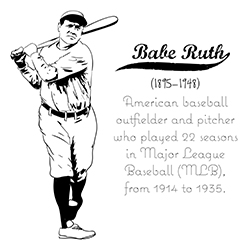 By Jan White
By Jan White
This email address is being protected from spambots. You need JavaScript enabled to view it.
Baseball season is in full swing. And although some would argue that baseball is no longer “America’s Favorite Pasttime,” it still ranks high as one of the most popular sports for both participants and spectators. Just the word “baseball” evokes more nostalgia than any other sport. Growing up, we heard names like Joe DiMaggio, Ted Williams, Sandy Koufax, Jackie Robinson, and of course, one of the most iconic players of the game – Babe Ruth.
George Herman Ruth began his professional career with Baltimore’s minor league team. Only nineteen at the time, the law stated that Ruth had to have a legal guardian sign his baseball contract for him to play professionally. Dunn became Ruth’s legal guardian, leading teammates to jokingly call Ruth “Dunn’s new babe.” The joke stuck, and Ruth quickly earned the nickname “Babe” Ruth. Over the years, Ruth earned him many different nicknames, such as “the Great Bambino,” “The Sultan of Swat,” and “the Colossus of Clout.”
Many baseball fans know the story behind Ruth’s rise to fame, but here are some interesting things you might not know about the baseball powerhouse.
He wasn’t an orphan
As with most legends, rumors abounded about Ruth’s humble origins, some labeling him an “orphan.” While Ruth did end up as a permanent ward of St Mary’s School for Boys, Ruth wasn’t technically an orphan. Ruth was raised in a poor waterfront neighborhood in Baltimore, where his parents owned a tavern. Unsupervised by his busy father and chronically-ill mother, George Jr. roamed the streets, sometimes drinking, chewing tobacco, engaging in petty thievery, and frequently skipping school. His parents deemed him incorrigible and sent him to St. Mary’s at the age of seven. When his mother died from tuberculosis in 1912, he became a permanent ward of the school.
He was arrested for reckless driving
Ruth was undisputed on the baseball pitch, stealing home ten times in his career and an estimated 714 home runs. He also displayed the same speed behind the wheel and subsequently accumulated an inordinate number of automobile accidents, traffic violations, and speeding tickets. Once, when Ruth was caught speeding through Manhattan, he spent the rest of the day in jail and was released forty-five minutes after his game had started. When they let him go, a motorcycle escort got him to the field in time to finish out the game.
His father died in a family brawl
George Sr. was behind the counter of his Baltimore saloon in August 1918 when two of his brothers-in-law started quarreling. Ruth joined in the argument, following one of the brothers into the street to continue the fight, where he took a fall, hitting the ground with the back of his head. He died from a fractured skull.
Ruth made his debut as a pitcher
While most people know Babe Ruth for his phenomenal 714 home runs, he started out as a left-handed pitcher in 1910. At the time, he played for the Boston Red Sox, winning eighty-nine games in six seasons. Once he joined the New York Yankees in 1920, they changed his position to an outfielder after just five games.
He did not retire as a New York Yankee
After the Yankees dropped him for his waning performance in 1935, Ruth signed with the Boston Braves, hoping to become the team’s manager the following season. But his declining health and reputation kept him from realizing the dream. After a twenty-two-year career in baseball, he retired in a Braves uniform, having only played 28 games for the team.
His first wife died mysteriously
After his rookie season, Ruth married Helen Woodford, who was just 16 at the time. In 1922, the couple adopted a daughter, thought to belong to one of Babe Ruth’s mistresses. The marriage did not last long, and the couple permanently separated after only a few years. In January 1929, a fire broke out in the Watertown, Massachusetts home of a dentist called Edward Kinder, leading to the death of his wife, Helen. However, after seeing her photo in the Boston newspaper, readers and family members realized her true identity just hours before her funeral. Helen Kindler was actually Babe Ruth’s estranged wife.
Ruth was the highest-paid baseball player at the time
His first contract with the Yankees saw him bag a staggering $20,000 salary, and by 1930, it had hit the $80,000 mark, which was the highest a baseball player had ever been paid. At the time, he made more than President Herbert Hoover, whose salary was $75,000. During his career, Babe Ruth made approximately one million dollars in wages and bonuses and even extra money from writings, endorsements, and other ventures.
He placed a piece of cabbage beneath his hat for cooling
Ruth had an unusual trick for keeping his head cool on the playing field. He would pry whole leaves off the head of a cabbage and spread them over ice in a cooler. When sufficiently chilled, the leaves under his cap would supply much-needed relief from the heat for at least a couple of innings before needing to be replaced. Although a seemingly bizarre idea, the Babe did convince a few of his fellow players to join him in the practice.
The Babe had brief careers in radio and film
Ruth appeared in several films, including the 1920 movie Headin’ Home and Pride of the Yankees, where he played himself. Ruth hosted The Adventures of Babe Ruth, which aired three times per week during the summer and spring of 1934, and Here’s Babe Ruth during the summer and spring of 1937. He ran a show known as Baseball Quiz during World War II, which aired on NBC every Saturday. As with his film career, these ventures were primarily short-lived.
His biggest regret was not managing a team
Ruth’s dream was to manage a major-league team, particularly with the Yankees, but he never got the opportunity. Rumors of his enormous appetite for food, alcohol, and women and his tendency toward extravagant spending and high living were as legendary as his exploits at the plate. Whether actual or imagined, this reputation hurt Ruth’s chances of becoming a team manager. In 1935 he was lured back to Boston to play for the Braves and for the opportunity, so he thought, to manage the club the following season. But the job never materialized. Instead, George Herman Ruth, known throughout his life as a generous man, devoted his later years to charitable events. On June 13, 1948, he made one final appearance at Yankee Stadium to celebrate the building’s 25th anniversary. Sick with cancer, Ruth had become a shadow of his former, gregarious self. Two months later, on August 16, 1948, The Great Bambino died.

